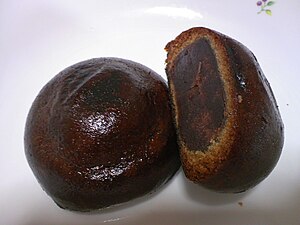Manjū: Difference between revisions
→See also: mandu |
m →See also: Remove blank line(s) between list items per WP:LISTGAP to fix an accessibility issue for users of screen readers. Do WP:GENFIXES and cleanup if needed. Discuss this at Wikipedia talk:WikiProject Accessibility#LISTGAP |
||
| Line 38: | Line 38: | ||
* [[Manti (dumpling)|Manti]] (Turkic) and [[Mandu (dumpling)|mandu]] (Korean), filled dumplings with the names being cognate with mantou and manjū |
* [[Manti (dumpling)|Manti]] (Turkic) and [[Mandu (dumpling)|mandu]] (Korean), filled dumplings with the names being cognate with mantou and manjū |
||
* [[Nikuman]] |
* [[Nikuman]] |
||
*[[Tangyuan (food)]] |
*[[Tangyuan (food)]] |
||
Revision as of 09:44, 19 March 2016
You can help expand this article with text translated from the corresponding article in Japanese. (October 2012) Click [show] for important translation instructions.
|
This article needs additional citations for verification. (November 2007) |
 | |
| Type | Wagashi |
|---|---|
| Place of origin | Japan |
| Main ingredients | Flour, rice powder, buckwheat, red bean paste |
Manjū (饅頭, まんじゅう) is a popular traditional Japanese confection. There are many varieties of manjū, but most have an outside made from flour, rice powder and buckwheat and a filling of anko (red bean paste), made from boiled azuki beans and sugar. They are boiled together again and kneaded. There are several varieties of bean paste used including koshian, tsubuan, and tsubushian.
History
Manjū was derived from a type of mochi (蒸餅), or pounded rice cake, that has existed in China for a long time.[when?] It was originally called Mantou in Chinese, but became known as manjū when it came to Japan. In 1341, a Japanese envoy that came back from China brought back manjū with him and started to sell it as Nara-manjū. It is said that this was the origin of Japanese manjū. Since then, it has been eaten for nearly 700 years by Japanese people. Now it can be found in many Japanese sweet shops. Its low price is a reason that it is popular.
Varieties

There are myriad varieties of manjū, some more common than others.
- Matcha (green tea) manjū is one of the most common. In this case, the outside of the manjū has a green tea flavor and is colored green.
- Mizu (water) manjū is traditionally eaten in the summertime and contains a flavored bean filling. The exterior of the mizu manjū is made with kuzu starch, which gives the dough a translucent, jelly-like appearance.[1]
- There are also manjū that have different flavored fillings, such as orange-flavored cream.
- As is the case with many Japanese foods, in some parts of Japan one can find manjū unique to that region, such as the maple leaf-shaped momiji manjū in Hiroshima and Miyajima.
- The regional variety of the Saitama prefecture is called Jumangoku Manju.
See also
![]() Media related to Manjū at Wikimedia Commons
Media related to Manjū at Wikimedia Commons
- Daifuku
- Mantou (饅頭, Chinese plain steamed bun), etymologically the origin of the word, although in modern Chinese the term for filled buns is baozi
- Manti (Turkic) and mandu (Korean), filled dumplings with the names being cognate with mantou and manjū
- Nikuman
- Tangyuan (food)
References
- ^ Schilling, Christine (2007). "Translator's Notes." in Kirishima, Takeru (2002). Kanna Volume 2. California: Go! Comi (Go! Media Entertainment, LLC). ISBN 978-1-933617-56-5
